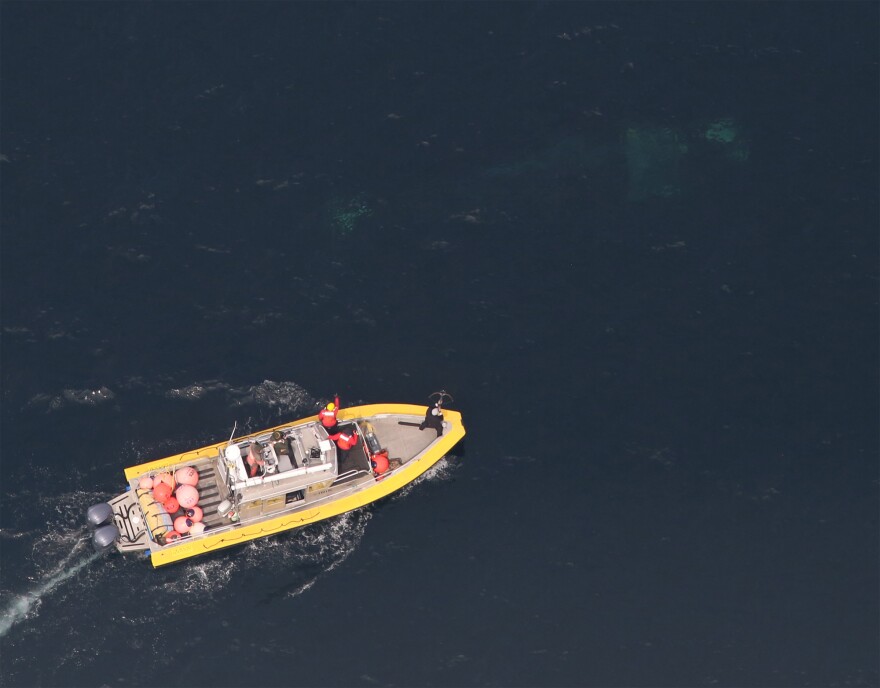North Atlantic right whales are severely endangered, and entanglement in fishing gear is a leading cause of both deaths and low birth rates. A small Provincetown-based team tries to free as many whales as possible each year, but these efforts are dangerous and not a permanent solution.
When an entangled whale is sighted in New England, the call comes here - to the Marine Animal Entanglement Response team at the Center for Coastal Studies in Provincetown. The hotline phone is red, of course. After just one loud, shrill ring, the call goes directly to rescue assistant Everett Sacrey’s cell phone.

"First thing I do is grab my little pad and pen and paper over here," explains Sacrey, "We have a bunch of questions that we want to ask.”
As Sacrey takes down information about the location and condition of the animal, the team grabs their gear and heads for the response boat on MacMillan Pier.
"It’s minimum time wasted and maximum time responding and trying to get to that animal,” Sacrey said.
That’s what happened on April 10th of this year. Researchers caught sight of a female North Atlantic right whale known as Kleenex who’s been entangled for more than three years. Take a second to think about that. Three years spent swimming around with rope wrapped through her mouth and around her head, and this is the first time responders have had an opportunity to help her.
“The line isn’t taut," said team leader Scott Landry. "That’s probably why she’s been able to survive for three years.”
Still, the entanglement has taken a toll. Kleenex is a mother multiple times over, but she hasn’t born a calf since getting entangled. And now, she’s showing signs of deteriorating health.
“Right whales should have bright, shiny, black skin. She’s turning pale," Landry explained. "You can see a silhouetted at the base of her skull. That area should be filled with fat. It should be a mountain, not a valley. And, then, she has whale lice in random parts of her body.”
This is not the way that we are going to conserve whale populations." - Scott Landry
Kleenex’s story is the story of the entire North Atlantic right whale population right now – entangled, in decline, future uncertain. More than eighty percent of all North Atlantic right whales bear the bright white scars of previous encounters with ships and fishing gear, and most have been entangled more than once.
“If you could look at a whale in the 18th century versus today, the whales today look as though they’ve been covered with graffiti," said Landry. "Their bodies are scarred from head to toe.”
The primary culprits here in the northeast are the ropes that attach marker buoys to lobster or crab traps on the sea floor. Those lines get wrapped around whales’ bodies, or caught in their mouths while they’re feeding. And as synthetic ropes have gotten stronger, the problem has gotten worse. Entanglement is killing whales and hindering the birth of new ones. And Landry says cutting ropes off whales is only a stop-gap measure.
“This is not the way that we’re going to conserve whale populations. It cannot be the long-term solution for dealing with the entanglement problem. It’s simply too dangerous for whales, and it’s certainly too dangerous for people.
Last year, Canadian disentanglement worker Joe Howlett died after being hit by a whale’s tail. Landry says his team’s safety is always his first thought, and they are all well aware of the risks.
“But we have to continue doing this just to keep these animals heads above water,” he said.

The disentanglement team spent the better part of two cold, windy days following Kleenex around in an open boat. Everett Sacrey and Bob Lynch took turns standing at the bow, holding a cross-bow at shoulder height, waiting for a clear shot to fire an arrow with four razor-sharp blades on the tip.
“Your legs are doing all the balancing for you. [So], your legs get tired," Sacrey said. "The crossbow is pretty light, but you try to hold anything up for four, or five, or eight, or ten hours throughout the day, you obviously get tired.”
Finally, the whale came up and Lynch took aim at the ropes on her head, some fifty feet away. Two of the blades damaged two of the ropes, but didn’t slice them completely. Ironically, if the lines were tighter, they would have been easier to cut. Instead, Landry and his team are left hoping that the ropes will give out before Kleenex does.
“All we can do is hope that it’s enough," says Landry, "not enough to save every one of them, but enough to keep the population going long enough for us to solve this problem.”
One solution may lie in new ropeless fishing technologies that would reduce the number of lines in the water. Landry says he looks forward to the day when lobstermen can go to work, and he doesn’t have to. Until then, he’ll be ready for that red phone to ring again.







